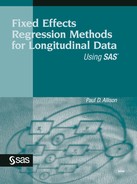5.1. Introduction
In both the social and biomedical sciences, there is a great deal of interest in regression models for predicting the occurrence and timing of events. Medical researchers primarily study deaths, but they may also model such events as infections or tumor recurrences. Social scientists are interested in a wide array of events, including births, marriages, divorces, job terminations, promotions, arrests, residence changes, and so on.
Statistical methods for modeling events are often called survival analysis because they were originally developed by biostatisticians to analyze the occurrence of deaths. But I prefer the term event history analysis, commonly used among social scientists, because it more aptly expresses the generality of these methods, and because it is particularly appropriate for modeling repeated events, which are a major focus of this chapter.
To do an event history analysis, you need a set of event history data, which is simply a longitudinal record of when events occurred to some individual or sample of individuals. Here's an example that we'll use throughout this chapter. In the 1995 National Survey of Family Growth (NSFG), a representative sample of American women was asked to report information on the births of all children ever born to them (http://www.cdc.gov/nchs/nsfg.htm). In the version of the data used here, 6,911 women reported on 14,932 live births. For each of these births, I calculated a birth interval labeled DUR: the length of time (in months) from the current birth to the next birth, or until the interview date if no subsequent birth was observed. As potential predictors of these birth intervals, several variables characterize the current birth:
PREGORDR
Order of the birth (1 through 15)
MARRIED
1 if married at the time of the birth, otherwise 0
AGE
Mother's age (in years) at birth
PASST
1 if delivery was paid for, in part, by public assistance funds, otherwise 0
NOBREAST
1 if mother did not breast feed baby, otherwise 0
LBW
1 if low birth weight, otherwise 0
CAESAR
1 if birth was by Caesarian section, otherwise 0
MULTIPLE
1 if more than one baby born, otherwise 0
There is also a variable COLLEGE, which is equal to 1 if the woman had some college education (at the time of the interview), and is otherwise 0; and a variable BIRTH, which is equal to 1 if the interval ended in another birth, or 0 if the interval was terminated by the interview (a censored interval). Finally, there is a variable CASEID, which is an ID number that is common to all the birth intervals for the same woman. The goal is to estimate a regression model predicting the length of birth interval.
